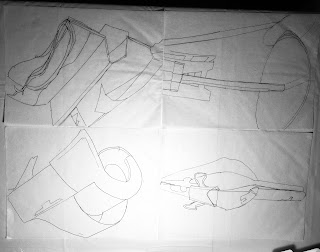A friend asked me to make a photo album for a gift. I have made small photo albums before and so I was happy to make a larger one for him. Once we started talking about what was going in the album (30 stories written on 8.5" x 11" paper) I realized it would need to be a very large photo album.
I started by determining the album pages would need to be 12" x 12". This would allow a margin around the papers that would be attached to the pages. It is also a standard size so I was able to purchase the pages. I then needed to determine the size of the book cloth and decorative paper needed to cover the book board. Once I had the dimensions I was able to order the materials I needed.
Cutting the materials:
- 4 book board pieces (2 for the back and 2 for the front).
- 4 book cloth pieces 2 for the back and 2 for the front).
- 4 decorative exterior paper pieces (2 for the back and 2 for the front)
- 2 decorative interior paper pieces (1 for the back and 1 for the front).
NOTE: It is important to mark front vs back and top vs bottom so you can punch and assemble the pieces without any misalignments.
I made a 3 hole template for punching the book board spine pieces, and punched them.
Before gluing the paper and cloth to the book boards, I checked to be sure they were the correct sizes so everything would fit together correctly.
I began by gluing the book cloth onto the outside of the back and front book board pieces. The corners were cut and the book cloth edges wrapped around and glued to the interior of the book boards. The 2 smaller pieces of book cloth were glued over the spine on the inside, covering some of the exterior book cloth edges. The 3 holes now covered by the book cloth were carefully re-punched.
Next the decorative paper was glued to the outside of the front and back book board. The corners were cut and the paper edges wrapped around and glued to the interior of the book boards.
Finally the 2 large decorative interior pieces of paper were glued in place, covering the remaining edges of book cloth and exterior decorative paper.
I made a second 3 hole punch template with a narrower margin along one edge to use with the 30 book pages and 31 spacers. This moves the edge of the pages away from the spine edge of the book. After punching the 61 pieces I assembled the book.
I actually made two books, so my friend would have a choice of colors.





























